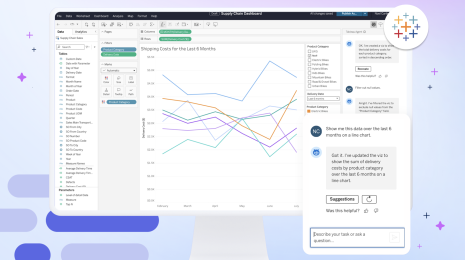Agentic Analytics: Why Human Curiosity is Your Ultimate Differentiator
As data professionals, we live at the intersection of information and impact. In an era of AI-driven speed and scale, what does it mean to make not only smart decisions but also wise ones? It begins with a universal question we’ve all asked—even as toddlers: Why?
"Why" is the cornerstone of curiosity. And in the data world, it's the fuel for understanding.
There is a danger in overindexing on the “see” part of Tableau’s mission statement. It is the same trap of failing to realize that “visual analytics” is not just visuals. Analytics is part of that phrase as well.

Tableau is not in the business of seeing, we’re in the business of understanding—of exploring your data to uncover facts, patterns, and anomalies, and transforming them into meaningful insights that drive action.
From information to anxiety
We live in a time that’s often referred to as the "Information Age," yet many of us feel more overwhelmed than informed.
The information age is no longer adequate as an image for the present, let alone as a guide to the future… Information itself does not enlighten… Focusing on mere information has led to overload of ever-less meaningful billions of bits of fragmented raw data, rather than the search for meaningful new patterns of knowledge.
Even in the 1980s, the dawn of personal computing, Richard Saul Wurman described this itch to know as information anxiety—that gnawing feeling that we’re constantly behind on news, updates, pings, and posts.

Why do we chase AI and agentic tools so passionately today? I think it is because deep down, we want relief. We can finally understand what we did not even know to ask.

We crave the clarity that helps us navigate a world drowning in data.
But relief won't come from outsourcing understanding. It comes from creating systems that honor human context and judgement, and ways of knowing that are beyond the bits and bytes of the machine.
Bridging data gaps that matter
When the data gap got personal
It was 3 AM in March 2023 when I jolted awake to find my partner collapsed on the floor, writhing in pain. Something was clearly wrong and every bump in the road on the way to the ER felt unbearable—all I could do was drive as safely as possible.
When we arrived, the ER staff did what they could. They administered pain medication within the limits they had. But here’s the thing: they didn’t know that my partner was in post-surgical op care in their own hospital. Their system didn’t connect the dots.
The result? They couldn’t go beyond the standard dosage without explicit clearance—clearance that took far too long through too many systems.
In those hours, I watched someone I love suffer. And I kept thinking: this isn’t just a medical issue. This is a data issue. There has to be a better way.
That night made something crystal clear. When systems don’t talk to each other, people fall through the cracks. And while AI alone isn’t the answer, it can help bridge these kinds of gaps—linking the right records, surfacing the right context, and prompting the right questions so that care can be smarter, faster, and more human.
If we can do this across all areas of the human experience, what a world we’ll live in!
The rise of generative AI
Why now?
AI isn’t new, —but its recent consumerization is unprecedented. In 2023, Bloomberg valued the generative AI (GAI) market at $1.3 trillion over 10 years. (Side note: If you were to stack $100 bills, this stack would be more than 2.5x as high as the International Space Station!)
I would argue that the excitement for GAI stems from the tectonic shift on how we relate to information. A new mode of interaction: conversation.
We’re no longer coding queries or translating thoughts into clicks and machine UIs, we’re talking about our data and to our data.
But is this conversational illusion dangerous? We might forget we’re speaking to a machine that doesn’t actually “understand.” We run the risk of the illusion of the conversation creating a delusion of understanding.
The role of the data professional
AI can answer the questions we ask but humans are the ones that question the questions. If AI is solving the velocity issue, humans offer wisdom to this information pipeline.
Information is just data.
Data with context is knowledge.
Knowledge with experience is wisdom.
You don’t want to have to recode wisdom.
The curiosity advantage
Organizations that win aren’t just data-rich—they’re question-rich. The best analysts switch between two modes of curiosity:
- Diversive curiosity is the expansive, open-ended exploration phase. This is where Tableau excels, enabling deep, flexible analysis.
- Epistemic curiosity is targeted investigation after a hypothesis emerges—when answers need speed and scale.
AI can amplify both by removing the time, effort, and skill barrier to insight. Conversational analytics can also remove the UI barrier, by providing something that feels more natural. However, without context, its results can mislead.
Tyler Vigen’s Spurious Correlations blog reminds us in humorous ways that numbers without narrative can be dangerously convincing.

Source images: Tyler Vigen
Here’s the key shift: in an AI-powered world, data professionals become the human trust layer. They move from knowledge workers to wisdom layers. From sourcing KPIs to shaping how those metrics are used, interpreted, and debated.
AI may accelerate outputs—are you familiar with the paper clip paradigm by Nick Bostrom?—but it’s humans who ensure outcomes are just, relevant, and aligned with purpose.
We should avoid competence without comprehension. The antidote is clear: Ensuring that the context is grounded, the questions are sound, and the insights are well-formed.
What changes now?
- Skillsets evolve. We’ll need not just analysts and engineers, but philosophers, ethicists, and storytellers who understand the fabric of decision-making and human trust. AI handles velocity and volume. Validation now lives with us.
- Curiosity becomes a core skill. AI answers the questions we ask. But humans ask the questions we should be asking. Let’s not outsource our curiosity—let’s double down on it.
- Meaning matters more than ever. We “know” things not just through numbers, but through stories, shared experiences, and gut instincts. There’s value in that ambiguity. Let’s preserve it, even as we automate.
From knowledge to wisdom
Data is only the beginning. Information is data in structure. Knowledge is structured information with context. Wisdom is knowledge tempered by experience, judgement, and purpose. AI can accelerate answers. But only humans can ensure those answers are wise.
As we navigate this new world together, to my fellow data professionals – let’s remember: You are not just data workers. You’re not even just knowledge workers. You are wisdom workers. You are guides in a world increasingly driven by intelligent machines—but still, and always, made meaningful by human insight. Let’s keep asking "why." Let’s stay curious. And let’s build organizations that are not just smart, but wise.
Want to make agentic analytics a strategic advantage for your organization? Learn how to cultivate your data culture for the agentic era with the Tableau Blueprint.









